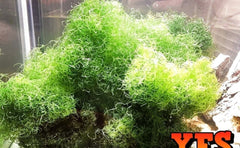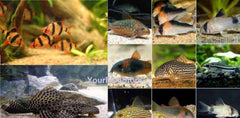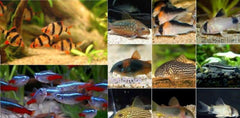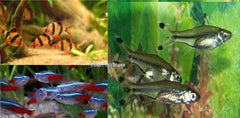X20 Pearl Danio
Ebay
$ 121.53

X20 PEARL DANIO - MINNOWS - MINNOW - LIVE FRESHWATER - FREE SHIPPING
Approx >1" - 1 1/2" Each
*Package includes a total of 20 fish*
DANIO CARE
Diet & Feeding
Hikari Danio FoodBeing the hardy little fish that they are, Danios are far from fussy eaters. They will eat just about anything you feed them. However, since the goal is to keep them as healthy, and as happy as possible, it’s always recommended that you try to imitate the diet they would naturally follow in the wild, which would be lots of small insects, worms, algae and crustaceans. Obviously, not all fish keepers will have the budget, nor the desire to feed their fish nothing but live foods, so a good quality flake food will more than suffice, but we highly recommend supplementing their diet with the occasional live food or frozen foods.
Our favorite Danio food, and the small mouthed fish food we highly recommend are the Micro Pellets from Hikari. We have been using this for a while now, and our fish can’t get enough of it.
As far as live foods go, you can’t go wrong with regular feedings of blood worms and black worms, brine shrimp and daphnia, and even wingless fruit flies. If you have the budget, or access to live foods, then stick with those, but if not, they simply use frozen foods instead.
Danio Tank Conditions
Although Danios can be found in a variety of different environments in the wild, they do prefer to live in water that has a small amount of current. However, since the majority of Danios that are bred today are done so in captivity, they are incredibly hardy, and can survive and even thrive in pretty much any aquarium. Due to their small size, Danios can survive in tanks as small as 5 gallons, but since they are a community fish, and they can seem hyperactive at times, they are better suited to larger, busier aquariums. We recommend keeping Danios in at least a 10 gallon tank, or even bigger if possible. fish love to swim, so keeping them in a larger tank will help them thrive.
Danios are schooling fish, so they need to be kept in groups of at least 5. As with most other schooling fish, if the numbers are too low, they can become stressed, and start acting out of the ordinary, and can portray symptoms such as aggression towards other tank mates, and loss of appetite.
Danios will thrive in waters that are consistently between 65 and 77 degrees Fahrenheit, and they prefer soft to medium hard waters with a pH of 6.5 to 7.2.
In terms of filtration, Danios are not demanding at all. You can use any type of filter you prefer, but we would recommend a HOB filter, purely for the increased current they can provide for the danios to play in.
Danios have been known to be quite the little jumpers, so we recommend that you always keep your tank covered, if you don’t want to come home to a school of dead fish on your floor. If you provide them with plenty of space to swim around, and a nice current for them to enjoy, you will more than likely be the owner of a bunch of happy danios.
MINNOWS CARE
Because Minnows are so peaceful they make great community tank inhabitants. You do need to keep in mind, however, that some Minnows come from mountain stream environments where the water is fairly cool. The ideal temperature range for most Minnows is between 64°F and 72°F with a water hardness between 10 and 15 KH and a neutral pH between 6.5 and 7.5. A tank for Minnows should be decorated with live plants, rocks, and driftwood to provide hiding places with plenty of open space for swimming.
Origins
Minnows can be found all over the world but one of the most popular aquarium species, the White Cloud Mountain Minnow, is native to the mountains of China. A number of Minnow species can be found throughout North America as well.
Color
For the most part, wild Minnows have very drab coloration – they are generally silver or dull gray in color, sometimes with black or colors accents on the fins. Minnows sold in the aquarium hobby may be selectively bred in certain colors. The White Cloud Mountain Minnow, for example, has red coloration in the fins and sometimes on the body.
Feeding
In the wild, Minnows generally feed on small crustaceans, insect larvae, plant matter, and other detritus. In the home aquarium, these fish are likely to accept a wide variety of commercial foods including flakes and pellets as well as fresh and frozen foods.
Breeding Info
In many cases, Minnows are as easy to breed in the home aquarium as tetras. All Minnows are egg layers and most of them scatter their eggs over plants or substrate after fertilization. Minnows do not show any parental care behaviors following spawning.
Different Type Of Minnows
White Cloud Mountain Minnows
White cloud mountain minnows are rarely spotted in the wild, but they are popular tank and pond pets. Their look is similar to that of the neon tetra; as a result, they are sometimes incorrectly sold as such. These minnows get no bigger than 1.5 inches. You can identify them by their bright red _caudal fin_s, or tail fins. As they are relatively calm and peaceful in nature, you can keep a school on their own, or you can keep them with other species of fish.
Fatheads
Reaching 2 to 3 inches in length, fathead minnows are so called due to the black fleshy pads that appear on the heads of males during breeding time. Fatheads are silver to dark-olive in color, with pale underbellies and two dark stripes that darken during mating: a dorsal stripe and a lateral stripe. They tend to group in schools until breeding time, when they separate into pairs until the fry are born.
In the wild, fathead minnows inhabit rivers and streams, as well as muddy pools. Fathead minnows are sturdy little fish, able to withstand high variances in temperature, turbidity, pH and salinity levels, and oxygen. This makes them excellent options for outdoor pond raising.
Rosy Reds
Rosy red minnows are actually a variant of fatheads. Bright orange to dusky red in color, they stand out from their darker cousins and are a beautiful addition to aquariums. Fatheads and rosy reds prefer open space to school, and they like to breed in caves or overhangs.
Most rosy red minnows are found at pet stores or aquariums, kept in dense schools. These fish may prove stunted or unhealthy from their pet store conditions, but the fry they produce should have better coloration and size if you care for them attentively.
Aquarium Care
Because minnows are schooling fish, it's best to keep them in group of mated pairs. Four or five adult pairs will fit comfortably in a 15-gallon aquarium. Providing gravel and aquarium ferns will help make your fish happier and aesthetically improve your aquarium setting. Install cavelike objects such as pottery, freshwater rock or nontoxic aquarium pieces to encourage your minnows to mate and breed.
A simple sponge filter is enough for filtration. Add an air supply for oxygenation. Feed your minnows once a day, and keep the temperature between 64 degrees and 79 degrees Fahrenheit. Above all, pay attention to your fish. If they are lethargic or sickly, contact your local aquatic specialist.
Pond Care
Raising minnows in a pond is not very different from aquarium care. A benefit to ponds is the use of live local plant matter for a dietary staple and free-ranging insects to serve as snacks. It's best if your pond is away from places where leaves or debris can easily foul it.
If you fill your pond with water from a garden hose, add water conditioners to the pond at least three days before adding your first minnows. Add screens to keep your fish safe from predatory land animals and to prevent escape artists from leaping onto land. It's not necessary to filter or aerate your pond unless you stock hundreds of fish, although a small fountain or water wheel can prevent a pond from becoming stagnant.
Whether you raise your minnows in their own independent schools, or combine them with other shoals, these gentle species are hardy, helpful and relatively easy fish to maintain.
QUESTIONS & ANSWERS
Have a Question?
Be the first to ask a question about this.














